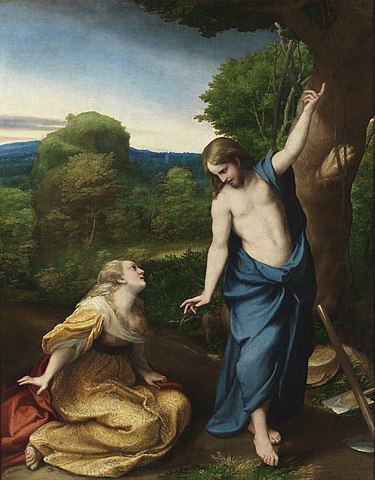
Noli me Tangere
Antonio da Correggio, 1525
My dear friends,
In John 20:11-18, we behold the tender moment when Mary Magdalene, heavy with grief, stands before the empty tomb and unexpectedly meets the risen Christ. Her sorrow transforms into awe and elation — a powerful shift of heart that mirrors the journey from suffering to awakening. Yet amidst this revelation, Jesus says, "Do not hold on to me." At first, this may appear puzzling, but viewed through the lens of the Bodhisattva path, it becomes a compassionate teaching on non-attachment and spiritual maturation.
Turning to John 14:15, Jesus states: "If you love me, you will keep my commandments." In the Bodhisattva tradition, this resonates with the practice of transforming love from emotional grasping into the active compassion of Bodhicitta. Jesus does not call for sentimental devotion, but for awakened conduct — living in harmony with the divine precepts of mercy, forgiveness, and selfless service. When he asks Mary not to cling, he invites her — and all of us — to embody his path, not to idolize his person.
In 2 Corinthians 5:16, we are reminded that our understanding of Christ must evolve: "…even though we once knew Christ from a human point of view, we know him no longer in that way." The Bodhisattva sees here a shift from relative truth to ultimate truth — from clinging to form, to realizing the timeless mind of Christ, akin to the realization of emptiness and compassion unified. The Resurrection unveils not merely the return of a beloved teacher, but the unveiling of the Dharmakaya — the radiant, boundless body of awakened wisdom and love.
Thus, "Do not hold on to me" is a gentle urging to renounce our attachment to appearances and to step into the stream of spiritual realization. As Mary is asked to release her clinging, so too are we invited to release our identification with ego, grasping, and the illusion of permanence. In this letting go, the energy of resurrection — like the birth of bodhicitta — arises within us, transforming sorrow into joy, and delusion into wisdom.
The Resurrection, then, becomes not a singular event in history, but an ever-unfolding revelation in the hearts of those who awaken. It teaches the same truth as the Bodhisattva path: that we are called to die to self-centeredness and arise into the life of sacred interconnectedness. By embodying the teachings of Christ — as one would the six perfections (paramitas) of the Bodhisattva — we become vessels of infinite compassion, dedicated to the liberation of all beings.
My dear friends, in celebrating the Resurrection, let us recognize it as a call to spiritual courage: to walk the path beyond attachment, to actualize the heart of Christ within us, and to serve as light-bearers in a world thirsting for peace. May this holy understanding illuminate our steps, strengthen our vows, and fill our lives with the joy of boundless compassion.
Through the light of divine wisdom, may all beings find peace, awakening, and the freedom beyond sorrow.